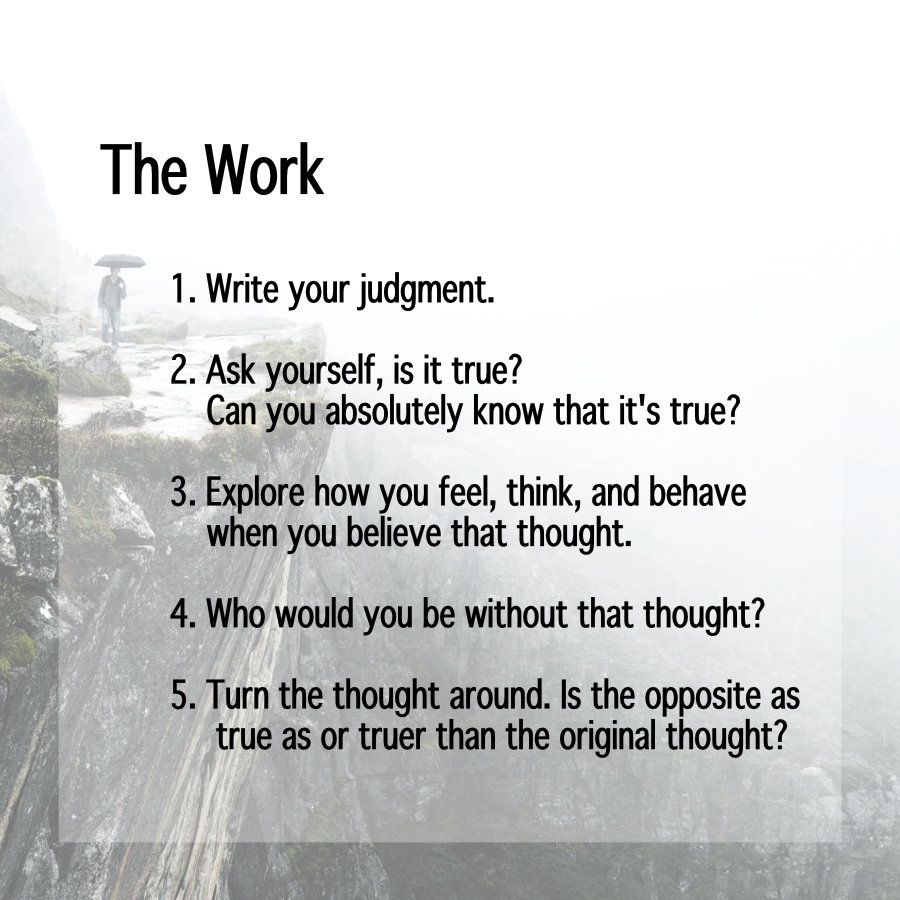Developing the witnessing-self enriches your spiritual life and helps your thinking-mind gain clarity and confidence. …

The Difference Between Perception and Truth, Exploring Byron Katie’s Process of Self-inquiry.
How can you tell what is true and not true?
I have been pondering the question: how to tell the difference between perception and truth, utilizing Byron Katie’s Process of Self-inquiry. I’m aware that telling the difference between what is true or untrue is not easy because the truth is in the beholder’s eye and in what resonates. And what may be right for one person may not be accurate for another.
I am exploring this question because I received an email from a client who asked me about The Byron Katie Self-Inquiry process, and how to tell what is true and not true.
My client’s question prompted this Q&A exploration. You can read her inquiry and my answer, plus a channeled message by Masiandia.
Question:
“What is the truth? When I see through a person’s behaviour, such as when a friend is passive-aggressive, am I projecting my perception, or is it the truth?”… “I am trying to follow Byron Katie’s inquiry process and want to be accountable for my feeling and needs. It’s important to me that I not project un-grounded perceptions. But what do I do with my observation? In my heart, I know my friend is passive-aggressive, but do I really?”
Answer:
When you can see the other person’s behaviour, such as passive aggression, without judgment and attachment, then there is nothing to inquire about. You simply observe the situation with curiosity and acceptance. You remain open to possibilities, rather than let your initial perception define your experience.
However, if you’re in reaction to what you perceive in the other, then Byron Katie’s process of inquiry is hugely beneficial because it opens you to a broader perspective.
The Work
Process of Self-inquiry
 When it comes to the first question in the self-inquiry practice, keep in mind that judgement is not the same as observation, and asking yourself whether it’s true or not doesn’t have to be taken literally. Your friend probably is being passive-aggressive.
When it comes to the first question in the self-inquiry practice, keep in mind that judgement is not the same as observation, and asking yourself whether it’s true or not doesn’t have to be taken literally. Your friend probably is being passive-aggressive.
The question “Is it true?” is not about your friend – it’s about you!
The significance of asking yourself the question, “Is this true?”, is about exploring the larger picture and therefore discovering what lies beneath your reaction, as well as your friend’s behaviour. It’s incredibly freeing to become aware of the underlying thoughts, feelings, and the needs of both you and your friend.
Exploring your thoughts, feelings and behaviour
When you have the thought that your friend is passive-aggressive, are you open or closed, curious or guarded, willing to communicate honestly or are you critical? Do you override your discomfort or set clear boundaries? Do you become passive-aggressive?
The Turn-Around
The turnaround is a great way to take responsibility for your own experience and to become even more aware of the bigger picture.
For instance, it could be equally valid to say that your “passive-aggressive” friend is afraid of being wrong or made wrong, or he/she may be feeling insecure and unsafe.
It could be just as true that you are protecting your feelings and, in some way, also being disharmonious, or that you feel threatened by his/her inc-congruent energy.
Taking self-inquiry to the next step – self-compassion
 I had a conflict that arose in my life a while ago with a friend who made a derogatory comment about me that affected me negatively. I could see that she was projecting an unconscious reaction onto me. But I, in turn, wasn’t clear about my boundaries, what I needed, or what I was not willing to tolerate.
I had a conflict that arose in my life a while ago with a friend who made a derogatory comment about me that affected me negatively. I could see that she was projecting an unconscious reaction onto me. But I, in turn, wasn’t clear about my boundaries, what I needed, or what I was not willing to tolerate.
I joined her in sympathetic resonance, thus viewing myself through her eyes. Trapped in my perception of what she thought of me, I then felt the need to defend myself. But her judgment had nothing to do with me.
So, what was I doing wrestling with her perception of me anyways? Who cares that she was incongruent. What matters is that I didn’t hold my ground; I didn’t say “no”; I didn’t take care of myself.
In retrospect, I can observe both hers and my reaction with understanding. I can see what was motivating my friend’s behaviour, and I feel compassion towards both her and me. I have a better understanding of what I needed in the situation and in how I could have taken better care of me.
Every situation provides so much information that can enable us to make conscious choices and take better care of the people and situations in our lives and our own needs. Hence, the importance of self-observation practices like The Work by Byron Katie, as well as the STEPS – a method I do daily to connect with my felt-sense experience for guidance.
Channeled Message
Masiandia, “There is an art to seeing beyond the masks that people wear, including your own. We are talking about idolized personas, unconscious reactions, patterns, conditioned behaviours.
“The art is choice – the intention to see and sense more through the eyes of awakened consciousness. That is not the same as intuitive or psychic ability. It has to do with non-judgmental observation.
“You can be a psychic that is non-judgmental or conversely adamant about being right. But, you can never be ‘right’ about what you see or sense because consciousness is vast, and your perception is limited to the human collective-agreement of reality, which is linear thinking. There always needs to be room for possibility.
“How do you observe reality through the non-judgmental witness when you are surrounded by a world society built on discrimination? We know, we know, this is challenging. But it is not unattainable.
“First, you must realize that making yourself wrong as a way to mitigate your judgment of others does not work. Neither does avoiding self-responsibility by pointing fingers towards others.
“Self-responsibility is of the essence, but that is not the same as self-punishment.
“Neither is self-responsibility the same as being meek, over tolerant and denying your intrinsic needs.
“So, perceiving reality through a more mature point of view, not habitual self-discrimination or projections onto others, requires that you allow yourself to be more than your human experience and collective agreement about reality.
“Life is not as linear as it appears. Probable realities play a significant role in your everyday interactions with others, and nothing is stagnant. There is no right and wrong answer, no good or bad people. There is a complexity of story lines, ancestral conditioning, multiplicities of purpose and intent, and the unfolding of your unconscious mind into awakened awareness.
“This means that whether you practice the Byron Katie work, the STEPS, meditate, process your feelings in a somatic or cognitive way, your inner resonance is of the essence.
“Inner resonance is the quality of your experience. Take a moment to listen from within when you feel slighted by other people’s words or actions, or when you feel uncertain of your behaviour. Turn into the complexity of your thoughts and feelings with a deep reverence for all of your experiences.
“Let’s not make any of it wrong. Instead, become a welcoming friend that nourishes all your life experiences, the joys and discomforts, the faith and despair, and the unknown. Let life surprise you by allowing yourself to see and sense more.”
❖
Join my mailing list, to receive notices of
channeled messages and spiritual insights.
❖
Feature Image by Daniil Kuzelev




Comments (0)